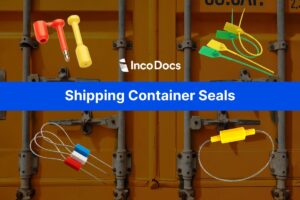Shipping documents can be confusing, especially when deciding between a Bill of Lading and a Sea Waybill. Each document serves distinct purposes in global trade and it impacts how goods are shipped and handled.
This article breaks down the differences and uses of each document, offering clear comparisons and considerations to help you make informed decisions. Whether you’re dealing with transferability, direct release of goods, or documentation requirements, our guide simplifies these concepts.
Bill of Lading explained
The Bill of Lading serves several crucial roles in global shipping, acting as the document for the import and export of goods. It might appear complex, but it simply indicates who sent the goods, who is carrying them, and who will receive them. The Bill of Lading document acts a a receipt that the shipping company has received the cargo and establishes ownership of the cargo, clarifying who legally owns the goods.
The holder of the original Bill of Lading has the authority to claim the goods or transfer this right to someone else in the supply chain. This makes the Bill of Lading central in facilitating smooth relations between all parties involved within a shipment.
Also read our blog post explaining the Bill of lading definition and it’s importance.
What is a Sea Waybill?
A Sea Waybill is a commonly used transport document for internationally shipping goods internationally. It functions as a receipt, showing that a carrier has received the goods and listing the shipment’s destination. Because it does not confer ownership, it simplifies the responsibilities of freight forwarders by streamlining the delivery process, especially useful in established trade relationships where no change in ownership is needed mid-transit. This feature makes it suitable for scenarios where ownership does not need to be transferred during transit.
The main advantage of using a Sea Waybill is its ability to streamline the delivery process at the destination port. Since it is not a document of title, the goods can be released directly to the named consignee without presenting the physical document. This means that the goods can be delivered to the person identified in the document, who can pick up the freight once it arrives, clears customs, and payment for the freight has been made to the carrier. They simply need to verify their identity to claim the freight. This reduces delays commonly associated with document transfer and customs clearance, making it a practical choice for trusted relationships or pre-paid shipments.
Additionally, Sea Waybills are particularly useful for shipments within the same company or between subsidiaries. They eliminate the need for securing goods against payment, as there is no requirement for document endorsement to prove ownership. This can significantly speed up operations and reduce administrative overhead.
Bill of Lading vs Sea Waybill: A Comparative Analysis

The Bill of Lading and Sea Waybill are two key documents, each serving distinct roles in the transportation of goods across international waters. Below is a comparative analysis of (BOL) vs Sea Waybill
Bill of Lading (BOL):
- Function: This document is multifunctional, acting as a receipt of the goods from the carrier, a contract for carriage, and a title document that signifies ownership.
- Usage: It’s essential when the goods are sold multiple times during transit, as it enables the transfer of ownership through endorsement of the document.
- Security: Offers legal protection and security for sellers and buyers, ensuring that the possession of goods can only change hands when stipulated conditions are met.
Sea Waybill:
- Function: Serves as a receipt of the goods and a contract of carriage but does not confer ownership.
- Usage: Ideal for shipments where no change in ownership is required during transit, such as sending goods to another branch of the same company or to a known and trusted recipient.
- Efficiency: Facilitates faster delivery at the destination because it doesn’t require the physical presentation of the document for the release of cargo.
These documents are fundamental in dictating the flow and security of goods shipped internationally, impacting how transactions are processed and how swiftly goods can be received. Understanding their roles and limitations ensures businesses can optimize their logistics strategies effectively.
Choosing Between Bill of Lading and Sea Waybill: Key Considerations
When choosing between a Bill of Lading and a Sea Waybill, consider a few key factors. Think about whether you need to transfer ownership of the goods during transit. Consider how quickly you want the goods released upon arrival. Also, evaluate the level of documentation required for your transactions. These considerations will help you in selecting the right document for your shipping needs.
Transferability and Negotiability
The choice between a Bill of Lading and a Sea Waybill often hinges on the need for transferability and negotiability:
- Bill of Lading: This document is ideal when transferability of ownership is required. It is negotiable, meaning it can be endorsed over to another party. This feature is particularly valuable in trades where the goods might be sold several times over while in transit. For example, commodities like oil or bulk grains are often traded on open markets and require the ability to quickly change hands.
- Sea Waybill: Lacks negotiability and is non-transferable. It is suited for scenarios where no change in ownership is required before the goods are delivered. This might be the case in shipments sent directly from a manufacturer to a known distributor or retailer, where the goods have been paid for in advance and no further trading is expected.
Direct Release of Goods
The speed at which goods can be released upon arrival is another critical consideration:
- Bill of Lading: Requires the consignee to present the original document to claim the goods. This process ensures security but can delay the release of goods, especially if the document is delayed or lost in transit.
- Sea Waybill: Facilitates a faster release of goods since it does not require the presentation of the original document. This document is best used when quick delivery is necessary, and the trading parties have a trust-based relationship, eliminating the need for the checks and balances provided by a Bill of Lading.
Documentation Requirements
The complexity and volume of paperwork can also influence the choice between these two documents:
- Bill of Lading: Involves more comprehensive documentation requirements, suitable for securing various forms of financing and insurance claims. It’s necessary when the shipment’s legal and financial details need rigorous documentation, often required by banks when goods are used as collateral in trade financing.
- Sea Waybill: Requires less paperwork, making the shipping process smoother and quicker. It is preferred when speed and efficiency are more critical than the detailed tracking of ownership and financial security, such as in the shipment of goods within the same company or when a pre-existing relationship of trust is established.
Financial Security and Risk Management
- Bill of Lading: Provides security by ensuring that goods are only released under specific conditions, such as after payment, which protects against non-payment and fraud.
- Ideal for complex transactions where ownership may change during transit.
- Acts as a document of title, which can be crucial in resolving disputes or managing payment risks.
- Sea Waybill: Streamlines the shipping process by allowing quicker release of goods, as it does not confer title.
- Best suited for transactions within trusted relationships where ownership does not change.
- Reduces administrative delays, enhancing efficiency in stable and secure trading conditions.
Legal Implications

Each document offers different levels of legal protection and suitability, depending on the nature of the shipment and the required compliance with international trade laws. Let’s explore how these documents differ in their legal implications.
- Bill of Lading:
- Offers legal protection as it is recognized globally as a document of title.
- Can be used in legal disputes to prove the receipt, transport, and delivery of goods.
- Crucial for transactions that require documentation for customs and insurance purposes.
- Sea Waybill:
- Does not provide legal title to the goods, limiting its use in legal claims.
- Suitable for quick and efficient transactions where legal documentation of ownership is not necessary.
- Simplifies transactions between established business partners by avoiding the legal complexities of title transfer.
Customs and Regulatory Compliance
Each document give different advantages that can impact the overall efficiency and legality of the shipping process. Here’s a closer look at how these differences play out in the realm of customs and regulatory compliance.
- Bill of Lading:
- Widely recognized by customs authorities around the world for its detailed information.
- Facilitates compliance with international shipping regulations due to its status as a document of title.
- Often required for certain goods that need close inspection or are subject to strict regulations.
- Sea Waybill:
- Less complex, making the customs process quicker where advanced trust exists between shipper and receiver.
- Suitable for goods that do not require transfer of title or are not highly regulated.
- Efficient for routine shipments where customs procedures are streamlined and well-established.

Here’s a clear and concise table summarizing the key differences between the Bill of Lading and the Sea Waybill across various considerations:
| Consideration | Bill of Lading | Sea Waybill |
|---|---|---|
| Transferability and Negotiability | Negotiable and transferable, ideal for multiple transactions en route. | Non-negotiable and non-transferable, best for direct shipments with no ownership change. |
| Direct Release of Goods | Requires original document for release, which can delay processing if documents are delayed or lost. | No original document needed for release, allows for quicker delivery and processing at destination. |
| Documentation Requirements | Extensive documentation needed, suitable for securing financing and handling complex transactions. | Minimal paperwork required, simplifies shipping and speeds up processes. |
| Financial Security and Risk Management | Provides security by controlling release conditions, helps prevent fraud and non-payment. | Streamlines processes, suitable for transactions within trusted relationships. |
| Legal Implications | Offers strong legal protections, can be used in disputes and claims, supports compliance. | Limited legal standing, not suitable for legal disputes over ownership but simplifies transactions. |
| Customs and Regulatory Compliance | Recognized for detailed information, aids in compliance and regulation adherence. | Less detailed but faster customs processing, suitable for less regulated or routine shipments. |
Frequently Asked Questions about Sea Waybill and Bill of Lading
Who Issues a Sea Waybill?
A Sea Waybill is issued by the carrier or their agent. The carrier creates the Sea Waybill once the shipper provides all necessary details and instructions for the shipment. This ensures that all information regarding the cargo’s origin, destination, and terms of shipping is accurately recorded and communicated to all parties involved in the transportation process.
Can a Sea Waybill Only Be Issued by the Shipper?
A Sea Waybill can only be issued by the shipper or their authorized agent. It is typically issued when the shipper has a direct, established relationship with the consignee, and the goods are not expected to change ownership during transit.
Is Sea Waybill the Same as Telex Release?
No, a Sea Waybill is not the same as a Telex Release, although both facilitate faster cargo release. A Sea Waybill is a non-negotiable document that does not require presentation for the release of cargo, used primarily when ownership doesn’t change during transit. It is issued from the start of the shipment and simplifies the entire process by eliminating the need for physical document handling.
In contrast, a Telex Release is used with a negotiable Bill of Lading. It is an electronic message sent by the origin agent to the destination agent indicating that the original Bill of Lading has been surrendered and the goods can be released to the consignee. This is typically used to speed up the release of goods when the original Bill of Lading cannot be physically presented in time.







